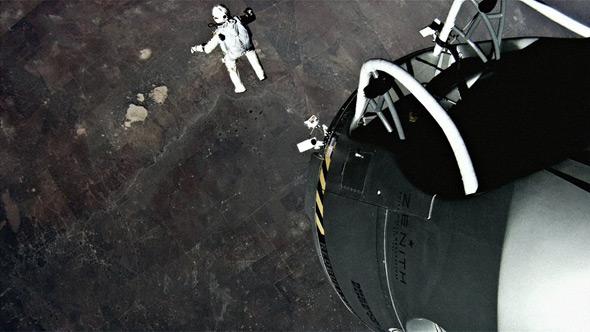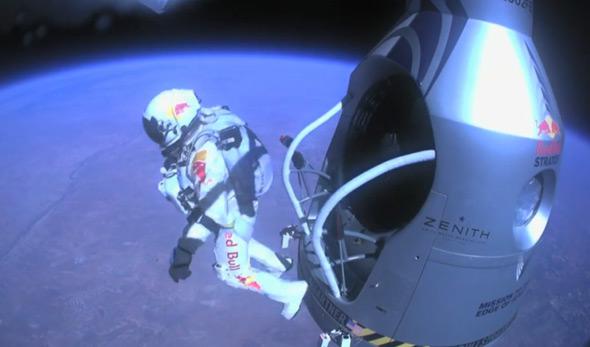Last year, daredevil Felix Baumgartner, sponsored by Red Bull, took a balloon up to a height of 39 kilometers (24 miles) and jumped out. Protected by a pressure suit, he quickly reached a speed of over 1300 km/hr (840 miles/hr). He fell for nine minutes before reaching the ground.
Snippets of the video from his helmetcam had been released before, but now the entire jump from start to finish has been posted:
Pretty interesting, and rather heart-pounding (as witnessed by Baumgartner’s heart rate going to nearly three beats per second). I strongly urge you to make it high-def and full screen. It’s pretty nifty.
Still and all, I have several brief thoughts about this I’d like to share.
First, even at the time, I was a bit cynical about the jump. A lot of people thought he was jumping from space, but that’s not at all the case; he was pretty dang high up, but the definition of space starts at an altitude of 100 km. He wasn’t even half that high up, and he was not in orbit; while the jump was technically very challenging and we may learn some engineering insight from it, I strongly doubt it’ll help NASA or private ventures learn much about escaping from a rocket on its way to (or already in) orbit. I explain at the link above, and my friend and space historian Amy Shira Teitel has details too.

Photo by Red Bull Stratos
I’ll note that Red Bull is careful to call this a jump from the stratosphere, which is correct. And don’t get me wrong: It was very cool, but overhyped in many circles. It should be taken for what it is.
Second, though, there is some fun stuff going on in the video. Baumgartner accelerates to a velocity of 700 km/hr in a mere 20 seconds. That means he was accelerating at an average of about 9.7 meters per second per second — just about what you’d expect for an object falling to Earth in a vacuum, where the only force is that of gravity. Pretty neat.
Another thing I found interesting was that as he fell the air became thicker, and he quickly reaches constant velocity. When you move around on Earth, you have to push air out of your way, and it pushes back. That’s a force acting on you, and the amount of that force depends on how quickly you move through the air, how much air you push aside (related to your surface area and shape; a cone moving tip-first has less air resistance than a cube, or a parabola facing into the wind, which is why parachutes slow you so much), and how thick the air is.
If you apply a force to an object, it accelerates. As a skydiver falls, the force due to gravity pulls them down, and their velocity increases. But the force of air resistance pushes them up, and increases as their velocity increases. Eventually those two forces balance, the acceleration stops, and the velocity remains constant. This is called terminal velocity, and for a human is very roughly 200 km/hr (120 miles/hr). You can watch Baumgartner’s velocity fall to just about that speed, though it varies somewhat as he falls and as he moves around.
Third, and finally, I want to point out that in an interview after he landed, Baumgartner poopooed NASA and the idea of exploring Mars. This made me a bit miffed, since I found his comments to be ill-measured, as well as simply wrong. Again, space historian Teitel wrote an excellent piece with which I agree. For one, NASA did a lot of groundwork that allowed Baumgartner’s jump in the first place. Second, he said that exploring Mars is a waste of time, when we should be learning more about Earth. But in fact that’s one of the very reasons we explore Mars! It’s so we can learn about Earth as a planet, compare and contrast it to other worlds, and thereby discover more about it. Of course we discover a lot about Earth by studying it in situ, but it’s only by going to other planets that we learn where our world fits into the rest of the Universe. That’s knowledge worth having.
So while I may disagree with Baumgartner on some issues, and also think the jump was little more than a publicity stunt for Red Bull, it’s still pretty cool, as is the video. The world is a nuanced place, where very few events are purely great or purely bad. And if this jump got more people interested in space exploration — as well as the technology and people behind it — then I think overall that’s a pretty good thing.
